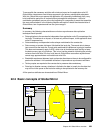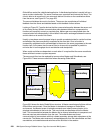
Chapter 22. Global Mirror overview 251
2. Present channel end and device end and acknowledge to the application successful I/O
completion. The application can then immediately schedule the next I/O.
3. Replicate the data from the primary storage disk subsystem cache to the secondary
storage disk subsystem cache.
4. Acknowledge to the primary storage disk subsystem that data successfully arrived at the
secondary storage disk subsystem.
From the previous procedure, note how in an asynchronous type technique, the data
transmission and the I/O completion acknowledge are independent process. This results in
virtually no application I/O impact, or at most to a minimal degree only. This also derives its
convenience when needing to replicate over long distances.
Global Copy non-synchronous technique
By its own, a non-synchronous technique like that of Global Copy, provides no guarantee that
the sequence of arrival of the applications write I/Os to the primary volumes is preserved at
the secondary site. In other words, the order of dependent writes is not preserved at the
secondary site. This is illustrated in Figure 22-5.
Figure 22-5 Global Copy sequence of data arrival not preserved at secondary site
Global Copy by itself as a non synchronous data replication method does not provide data
consistency at the secondary site.
In Figure 22-5 the sequence of data arrival at the primary site is record
b after record a. Due
to the way Global Copy cycles through its out-of-sync bit map, it may replicate record
a to the
secondary site after record
b. This assumes that, for example, record a is written to a primary
disk location that the Global Copy replication cycle just passed before. Global Copy may
approach another disk location that experienced just before an update with record
b. Then
record
b gets replicated to the secondary site before the replication cycle starts from the
beginning and finds record
a.
This situation may get even worse when involving multiple storage disk subsystems at the
primary site. As Figure 22-6 on page 252 shows, when using Global Copy, dependent writes
are not preserved at the recovery site when a failure occurs. This characteristic happens both
at a particular storage disk subsystem pair as well as across multiple storage disk
subsystems.
Primary
A
2C00
Primary
Primary
A
Primary
Storage Disk
Subsystem 1
Storage Disk
Subsystem 2
Server
b
a
b
a
b
a
in transit
SecondaryPrimary
3
1
2
4
Replicate
Non synchronous


















